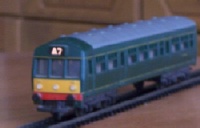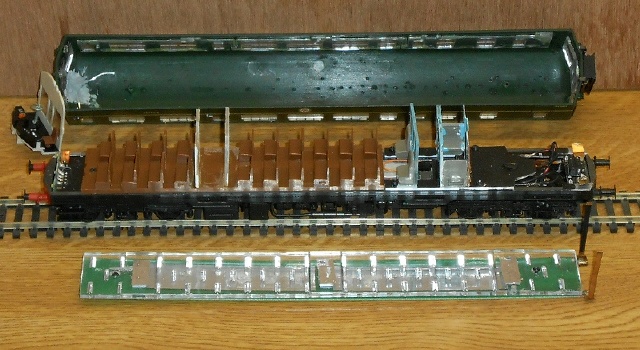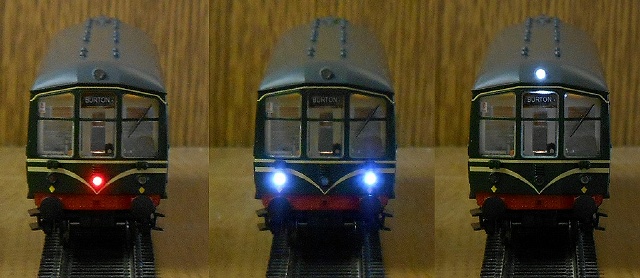DMUs
British Railways experimented with diesel multiple units from the early 1950s to try and bring down the costs of operating secondary routes. The Derby Lightweight DMUs were the first to be built in large numbers. They were built at BR’s Derby Works from 1954 to 1955 in various formations including one set built as a Battery Electric Multiple Unit used on the Royal Deeside line in Scotland between Aberdeen and Ballater from 1958.
• More on the prototypes here ...
The Models
 At different times, I picked up two secondhand Triang DMU sets which were based upon the 1955 Metropolitan Cammell lightweight DMUs. One of these even had directional destination code box lights controlled through diodes, but they were very dim unless travelling at high speed. I soon became dissatisfied with the crude design of the model, we take for granted these days such features as flush glazing, complete underframe detail, exhaust pipes, and so on. I decided to sell both on eBay and put the money I received toward replacing them with something better.
At different times, I picked up two secondhand Triang DMU sets which were based upon the 1955 Metropolitan Cammell lightweight DMUs. One of these even had directional destination code box lights controlled through diodes, but they were very dim unless travelling at high speed. I soon became dissatisfied with the crude design of the model, we take for granted these days such features as flush glazing, complete underframe detail, exhaust pipes, and so on. I decided to sell both on eBay and put the money I received toward replacing them with something better.
Bachmann now have a range of DMUs, Classes 105 and 108 and the Derby Lightweight units, all in a choice of livery. Although the Class 105 would be the obvious choice for my section of the Midland main line, I chose the Derby Lightweight as the prettiest looking unit and thought that it would not be stretching probability too much to have it running on my patch. However, I was not impressed with the large black brick enclosing the motor inside Bachmann’s otherwise lovely model. The motor is very large and would seem to be over powered.  The prototype is light and open with its large windows, so I decided to replace the motor with a Black Beetle motor bogie which fits out of sight under the floor. I sold the Bachmann motor unit on eBay. My modified open interior left no hiding place for a normal size decoder so I have used a TCS M4 decoder which fits within the underframe structure. I then added the missing seats and partition for the guard’s compartment. The picture here shows the modified interior prior to reassembly.
The prototype is light and open with its large windows, so I decided to replace the motor with a Black Beetle motor bogie which fits out of sight under the floor. I sold the Bachmann motor unit on eBay. My modified open interior left no hiding place for a normal size decoder so I have used a TCS M4 decoder which fits within the underframe structure. I then added the missing seats and partition for the guard’s compartment. The picture here shows the modified interior prior to reassembly.
Fortunately, Bachmann had equipped the full length of the roof with an interior lighting strip so my newly-exposed guard’s area didn’t need any further illumination. These are permanently lit by default, so I arranged them to be switched by a function call.
A glaring issue with the Bachmann model is the directional lighting. They seem to have forgotten that the prototype ran before the present day standard of a pair of white running lights to the front and in-built tail lights. The prototype was fitted with four white lights so that the traditional headcodes could be displayed. Bachmann have set the model up to display the headcode for a class 1 (express) passenger train. I consider that a class 2 headcode (ordinary passenger train or branch line passenger train) would be more appropriate. DMUs in the 1950s and 60s carried a traditional red oil lamp on a lamp bracket above a rear buffer, they were not equipped with built-in red lights. The model has a red LED in the position of the central white light to act as a tail light and I decided to live with this. The only time the bottom centre white light is needed for a passenger train is when it’s running as empty coaching stock.
 The top lamp position is equipped with a dummy lens so all I needed to do was to drill out the plastic from the back to expose the back of the lens and glue a warm-white LED in place. I can now select either class 1 or class 2 headcode and the tail lights can be switched separately. I have also replaced the destination blind with something more appropriate for my layout.
The top lamp position is equipped with a dummy lens so all I needed to do was to drill out the plastic from the back to expose the back of the lens and glue a warm-white LED in place. I can now select either class 1 or class 2 headcode and the tail lights can be switched separately. I have also replaced the destination blind with something more appropriate for my layout.
Bachmann provide no electrical connection between the cars, so a separate decoder is needed in each. The trailer car’s decoder is concealed in the toilet compartment, I chose a TCS FL4 to give full control of the lighting.
• Back to rolling stock ...
 At different times, I picked up two secondhand Triang DMU sets which were based upon the 1955 Metropolitan Cammell lightweight DMUs. One of these even had directional destination code box lights controlled through diodes, but they were very dim unless travelling at high speed. I soon became dissatisfied with the crude design of the model, we take for granted these days such features as flush glazing, complete underframe detail, exhaust pipes, and so on. I decided to sell both on eBay and put the money I received toward replacing them with something better.
At different times, I picked up two secondhand Triang DMU sets which were based upon the 1955 Metropolitan Cammell lightweight DMUs. One of these even had directional destination code box lights controlled through diodes, but they were very dim unless travelling at high speed. I soon became dissatisfied with the crude design of the model, we take for granted these days such features as flush glazing, complete underframe detail, exhaust pipes, and so on. I decided to sell both on eBay and put the money I received toward replacing them with something better. The prototype is light and open with its large windows, so I decided to replace the motor with a Black Beetle motor bogie which fits out of sight under the floor. I sold the Bachmann motor unit on eBay. My modified open interior left no hiding place for a normal size decoder so I have used a TCS M4 decoder which fits within the underframe structure. I then added the missing seats and partition for the guard’s compartment. The picture here shows the modified interior prior to reassembly.
The prototype is light and open with its large windows, so I decided to replace the motor with a Black Beetle motor bogie which fits out of sight under the floor. I sold the Bachmann motor unit on eBay. My modified open interior left no hiding place for a normal size decoder so I have used a TCS M4 decoder which fits within the underframe structure. I then added the missing seats and partition for the guard’s compartment. The picture here shows the modified interior prior to reassembly. The top lamp position is equipped with a dummy lens so all I needed to do was to drill out the plastic from the back to expose the back of the lens and glue a warm-white LED in place. I can now select either class 1 or class 2 headcode and the tail lights can be switched separately. I have also replaced the destination blind with something more appropriate for my layout.
The top lamp position is equipped with a dummy lens so all I needed to do was to drill out the plastic from the back to expose the back of the lens and glue a warm-white LED in place. I can now select either class 1 or class 2 headcode and the tail lights can be switched separately. I have also replaced the destination blind with something more appropriate for my layout.